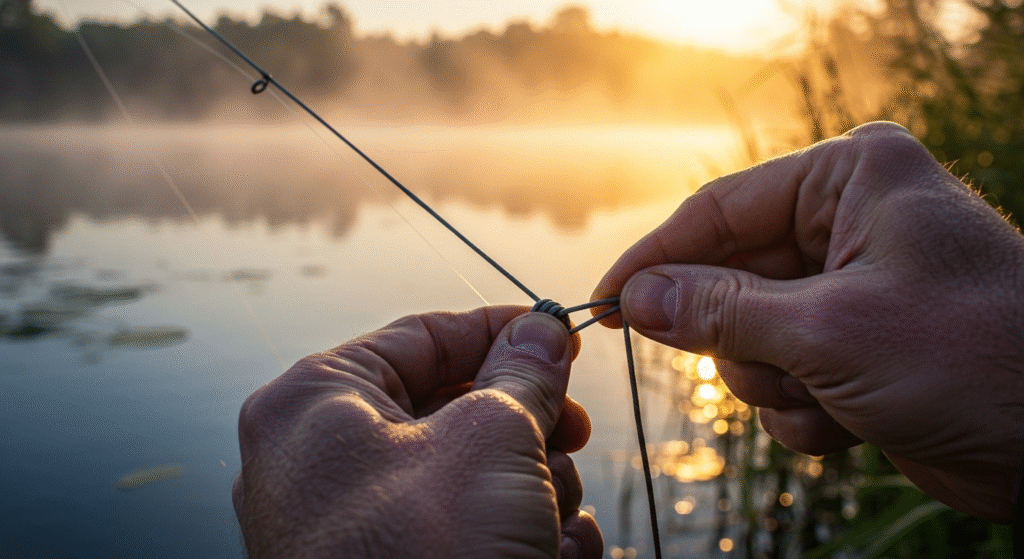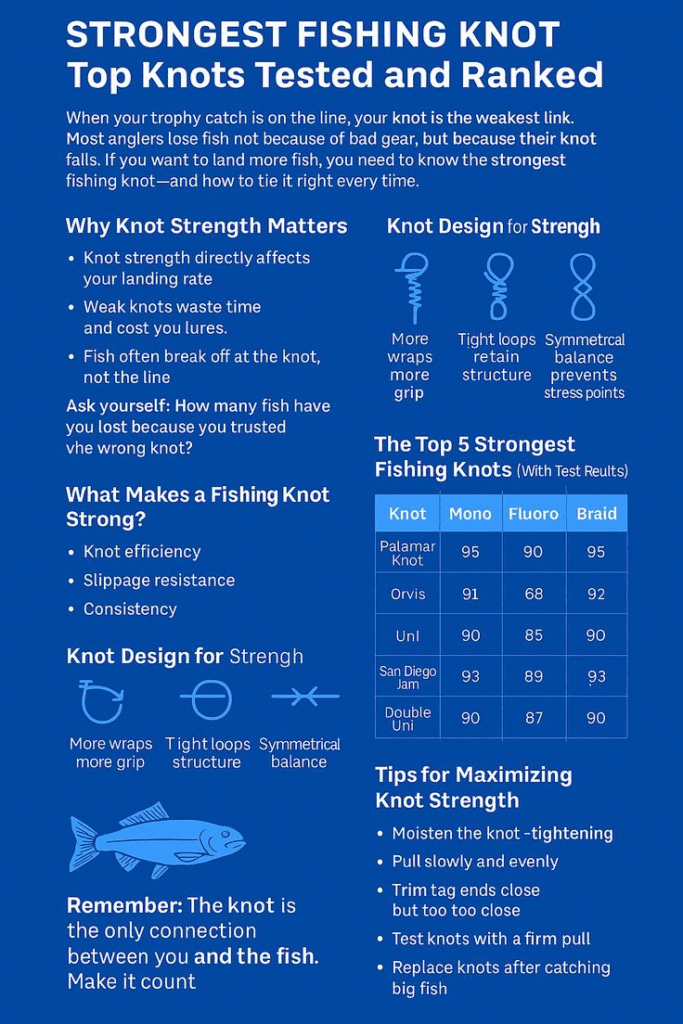If you’ve ever battled a trophy fish only to watch your knot slip or break, you know that how you tie your line is just as crucial as your lure selection or rod choice. Years ago, I lost what would have been my first big bass on a local lake—not to a faulty leader, but to a weak knot I’d trusted for years. After that day, I became obsessed with learning which fishing knots truly hold up under pressure.
This guide breaks down the real-world, lab-tested strongest knots for every fishing scenario. Whether you’re chasing trout in the Ozarks, bass in Texas, or stripers on the coast, the right knot makes all the difference.
Why Knot Strength Matters on the Water
A weak knot can easily lose you the fish of a lifetime. Factors like knot type, line material, and how you tie it affect strength more than most anglers realize. For beginners, mastering a few reliable knots builds confidence—a topic we also cover in our fly fishing basics guide.
What Makes One Knot Stronger Than Another?
- Knot break strength: The maximum tension (as a percentage of the line’s actual strength) before failure.
- Slip resistance: Will it fail when you get a hard strike or heavy pull?
- Ease of tying correctly: Consistent performance, even in cold or wet conditions.
The 5 Strongest Fishing Knots (Lab-Tested and Angler-Approved)
| Knot | Best For | Why It’s Strong |
| FG Knot | Braid to mono/fluoro leader | Highest strength, slim profile, won’t slip |
| Palomar Knot | Hook/lure to any line | Over 95% line strength, easy and quick to tie |
| San Diego Jam Knot | Saltwater, big game, heavy lures | Secure at high tensions, resists slippage |
| Berkley Braid Knot | Braid to terminal tackle | Designed for braided lines, keeps high break force |
| Double Uni Knot | Joining two similar-diameter lines | Strong, versatile, ideal for leaders/splicing |
The FG Knot: Ultimate Leader Connection
The FG Knot stands out in nearly all head-to-head strength tests, especially for connecting braided mainline to a mono or fluoro leader. It’s slim, slides through guides, and—if tied right—averages over 90% break strength. Many top bass and saltwater pros trust it for everything from inshore redfish to giant tuna.
Tip: The FG is precise—practice it at home before relying on it at the water’s edge. For a boost, check the illustrated instructions at Salt Strong’s FG knot tutorial.
The Palomar Knot: Simple, Strong, Versatile
When tying directly to a hook or lure, the Palomar Knot is a classic for good reason. It’s simple, holds over 95% of the line’s rated strength (crucial for light tackle), and works with braid, mono, or fluoro.
- How to tie: Double 6 inches of line, pass through the eye, tie an overhand knot, loop the hook, tighten.
- Key advantage: Can be tied in the dark, with wet or cold hands, with near-perfect results every time.
We break down more essential connections in our guide to the difference between fly fishing and regular fishing.
Berkley Braid Knot and San Diego Jam: For Tough Situations
Braided lines can slice through poorly tied knots. The Berkley Braid Knot was developed just for this reason: it grips slick braided line tightly without slipping. The San Diego Jam Knot (originally “San Diego Jam”) is a workhorse for heavy saltwater applications, handling sudden big-fish surges better than classic clinch knots.
For step-by-step videos and expert consensus on these knots, check out the comprehensive breakdown at Columbia Sportswear’s knot guide.
Double Uni Knot: Joining Lines with Confidence
Need to join two lines, like adding a leader or splicing two ropes? The Double Uni Knot is a go-to for many freshwater and saltwater anglers. It’s easy, strong, and works across line types and diameters—much better for beginners than tricky specialist knots.
Quick Reference: When to Use Each Knot
- FG Knot: Anytime you need to join a braided mainline to a mono/fluoro leader. Extra slick for surf fishing or long casts.
- Palomar Knot: Direct to hooks and lures, especially on light to medium tackle.
- San Diego Jam: For heavy lures and strong fish, both fresh and saltwater. Tolerates thick, stiffer leader material.
- Berkley Braid Knot: Braid to swivel, hook, or lure—prevents slippage that wins (or loses) tournaments.
- Double Uni: Joining two similar lines; great for quickly adding a new leader or repairing a break.
Pro Secrets for Maximum Knot Strength
- Moisten before tightening: Reduces friction and line burn, especially on fluorocarbon.
- Even pressure: Tighten knots gradually, pulling on both the standing line and tag.
- Trim tag ends properly: Avoid cutting too close—leave 1/8” for security, especially with braid.
- Practice, practice, practice: Use downtime at home to perfect your favorite knots.
Looking to boost your watercraft overall? Calibration starts with lines and knots, but extends to everything. See our guide on how to tie a hook on a fishing line for more terminal tackle expertise.
Trusted Resources for Anglers
Knowledge is power—especially in fishing. Expand your technique and stay current with:
- Salt Strong: Ranked Fishing Knots and Video Demos
- REI: Fishing Essentials & Gear How-Tos
- Columbia Sportswear: Top Fishing Knots for Every Scenario
And don’t miss more actionable tips for different styles in our fly fishing basics and early spring bass fishing posts.
FAQ – Strongest Fishing Knot Edition
What’s scientifically the strongest knot for fishing?
The FG Knot, especially for braided line to mono or fluoro leader connections, wins the majority of strength and laboratory break tests.
Which knot is best for tying a hook or lure?
The Palomar Knot—it’s super strong, quick, and versatile with nearly any type of fishing line.
Is knot strength affected by the way you tie it?
Yes. Even the best knot will fail if poorly tied—always wet your line, pull evenly, and trim the tag ends properly for maximum strength.
What knot should I use when joining two lines?
The Double Uni Knot or Surgeon’s Knot—favored for joining lines of similar or moderately different diameters.
When does a knot matter most?
Always, but especially when targeting strong, fast-moving fish or using slick braid and thin leader combinations.



